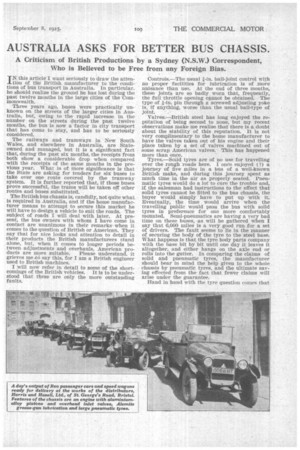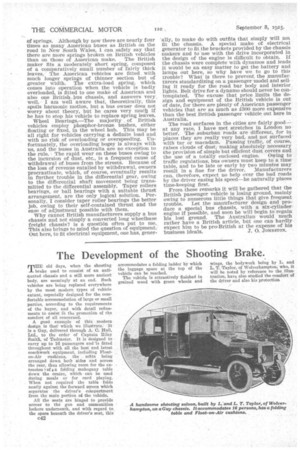AUSTRALIA ASKS FOR BETTER BUS CHASSIS.
Page 25

Page 26

If you've noticed an error in this article please click here to report it so we can fix it.
A Criticism of British Productions by a Sydney (N.S.W.) Correspondent, Who is Believed to be Free from any Foreign Bias.
TN this article I want seriously to draw the atten-Lion of the British manufacturer to the conditions of bus transport in Australia. In particular. he should realize the ground he has lost during the past twelve months in the large cities of the Commonwealth.
Three years ago, buses were practically unknown on the streets of the larger cities in Australia, but, owing to the rapid increase in the number on the streets during the past twelve months, the bus is now a factor in city transport that has come to stay, and has to be seriously considered.
The railways and tramways in New South Wales, and elsewhere in Australia, are Stateowned and managed, but it is a significant fact that, during the past six months, the receipts from both show a considerable drop when compared with the receipts of the same months in the previous year. What is of More significance is that the State are asking for tenders for six buses to take over one route covered by the tramway system. It is further reported that, if these buses prove successful, the trams will be taken off other routes and buses substituted.
The British bus chassis is, candidly, not quite what is required in Australia, and if the home manufacturer means to attempt to secure this market he will have to design a vehicle to suit the roads. The subject of roads I will deal with later. At present, the bus owners with whom I have come in contact are unanimous in their remarkswhen it comes to the question of British or American. They say that for nice looks and attention to detail in their products the British manufacturers stand alone, but, when it comes to longer periods between adjustments and overhauls, American pro ducts are more suitable. Please understand, it grieves me .to say this, for I am a British engineer used to British machines.
I Will now refer in detail to some of the shortcomings of the British vehicles. It is to be understood that these are only the more outstanding faults. Controls.—The usual 1-in. ball-joint control with no proper facilities for lubrication is of more nuisance than use. At the end of three months, these joints are so badly worn that, frequently, the full throttle opening cannot be obtained. The type of i-in. pin through a screwed adjusting yoke is, if anything, worse than the usual ball-type of joint.
Valves.—British steel has long enjoyed the reputation of being second to none, but my recent observations make me realize that there is a doubt about the stability of this reputation. It is not very complimentary to the home manufacturer to have the valves taken out of his engine and their place taken by a set of valves machined out of some scrap American valves. This has happened more than once.
Tyres.—Solid tyres are of no use for travelling over the rough roads here. I once enjoyed ( ?) a journey of five miles in a bus of a well-known British make, and during this journey spent as much time in the air as properly seated. Pneumatic tyres would do a lot to cure the trouble and, if the salesman had instructions to the effect that solid tyres cannot be fitted to the bus chassis, the buyer would simply have to put up with it. Eventually, the time would arrive when the travelling public would pass the bus with solid tyres in preference for one more comfortably mounted. Semi-pneumatics are having a very bad time on these buses, as will be gathered when I say that 6,000 miles is a very good run for a set of drivers. The fault seems to lie in the manner of securing the body of the tyre to the steel base. What happens is that the tyre body parts company with the base bit by bit until one day it leaves it altogether, and either hangs on the axle end or rolls into the gutter. In comparing the claims of solid and pneumatic tyres, the manufacturer should bear in mind the help given to the whole chassis by pneumatic tyres, and the ultimate saving effected from the fact that fewer claims will arise under the guarantee.
Hand in hand with the tyre question comes that of springs. Although by now there are nearly four times as many American buses as British on the road in Sew South Wales, I can safely say that there are more springs broken on British vehicles than on those of American make. The British maker fits a moderately short spring, composed of a comparatively small number of fairly thick leaves. The American vehicles are fitted with much longer springs of thinner section but of greater width. The extra-load spring, which comes into operation when the vehicle is badly overloaded, is fitted to one make of American and also one Britishbus chassis, and answers very, well. I am well aware that, theoretically, this spoils harmonic motion, but a bus owner does not worry about theory, but he cares very much if he has to stop his vehicle to replace spring leaves.
Wheel Bearings.—The majority of British vehicles employ phosphor-bronze bushes, either floating or• fixed, in the wheel hub. This may be all right for vehicles carrying a definite load and with no risk of overloading or overspeeding. Unfortunately, the overloading bogey is always with us, and the buses in Australia are no exception to the rule. The rapid wear on these buses owing to the incursion of dust, etc., is a frequent cause of withdrawal of buses from the streets. Because of the loss of revenue entailed by withdrawal, owners procrastinate, which, of course, eventually results in further, trouble in the differential gear, owing to the differential shaft movement being transmitted to the differential assembly. Taper rollers bearings, or ball bearings with a suitable thrust arrangement, are the only logical solution. Personally, I consider taper roller bearings the better job, owing to their self-contained thrust and the ease of adjustment possible with them.
Why cannot British manufacturers supply a bus chassis and not simply a converted long wheelbase freight chassis? is a questiOn often put to me. This also brings to mind the question of equipment. Out here, to fit electrical equipment, one has, gener ally, to make do with outfits that simply will not fit the chassis. A special make of electrical generator to fit the brackets provided by the chassis makers and to use with the drive incorporated in the design of the engine is difficult to obtain. If the chassis were complete with dynamos and leads it would be an easy matter to get the battery and lamps out here, so why have we to go to this trouble? What is there to prevent the manufacturers standardizing on a passenger-model and selling it ready for the road bar body and interior lights. Belt drive for a dynamo should never be contemplated. The excuse that price limits the design and equipment of the British vehicle is out of date, for there are plenty of American passenger vehicles that are as much as £300 more expensive than the best British passenger vehicle out here in Australia.
The road surfaces in the cities are fairly good— at any rate, I have met stretches in London no better. The suburban roads are different, for in places they are really very bad, and not surfaced with tar or macadam. Passing traffic, of course, raises clouds of dust; making absolutely necessary the provision of simple but efficient dust covers and the use of a totally enclosed engine. Owing to traffic regulations, bus owners must keep to a time table, and to be late or early by two minutes may result in a fine for the driver. Manufacturers can, therefore, expect no help over the bad roads by the driver easing his speed—he naturally places time-keeping first. From these remarks it will be gathered that the British passenger vehicle is losing ground, mainly owing to numerous little things that give frequent trouble. Let the manufacturer design and produce a special bus chassis, with a six-cylinder engine if possible, and soon he will begin to regain his lost ground. The Australian would much rather have a British article, but one can hardly expect him to be pro-British at the expeuse of his business ideals. J. 0. JOHNSTON.






























